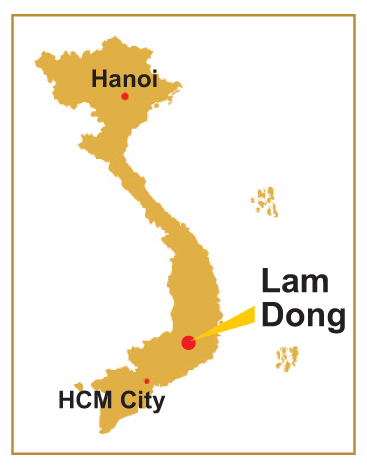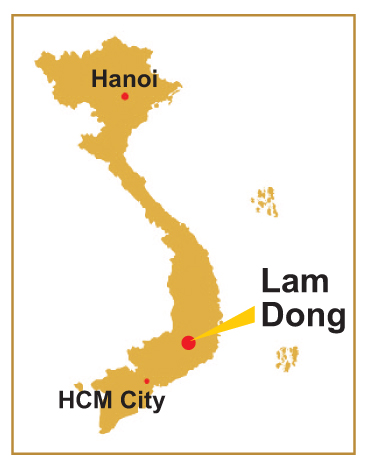(No.4, Vol.7,Aug-Sep 2017 Vietnam Heritage Magazine)


A wedding of K’Ho people
Photo provided by Hong Thuy Tien

K’Ho children, Lac Duong District, Dalat

A K’Ho family on the road, Lac Duong District, Dalat
Photos: MPK

K’Ho people, Lac Duong District, Dalat
Photos: MPK
The K’Ho custom of bridgegroom snatching
The western highlands of Tay Nguyen are full of mysteries. Small, stilted houses loom behind massive successions of mountains and heavenly gates, on windy slopes, amidst wild flowers and rumbling water falls. Taking a Zen moment in this deepest seclusion, one senses fully the primeval virginity of local life, a world away from city hustle and industrial clock.
Highland life means bright, black smiling eyes of kids shyly looking out from behind bamboo screens, yellow corn hung above the fireplace, gourds filled with water, jars and gongs of various sizes, and back baskets full of forest veggies and stream fish.
People here are a tiny inherent part of the colossal natural elements, which define and compose their ethnic nature. Their self-sufficient lifestyle irresistibly allures and mesmerizes those who want to explore, blend in with and melt into the customs, rituals and ceremonies passed down through time and history from the days the world was born.
One of the customs well preserved until today, one which is the purest symbol and freshest expression of matriarchy, is that of the bridegroom snatch.
In North Tay Nguyen, as Po Lang flowers bloom, Je-Trieng young girls go into the forest to collect firewood and to snatch their grooms. But in South Tay Nguyen, living on higher mountains in seclusion, the ancient K’Ho ethnic people manage to preserve the custom of snatching the grooms at midnight. In the matriarchal society, women play a higher role, and so they are supposed to take initiative in love, choosing life partners, inciting marriage and beginning family life.
Tay Nguyen people’s bridegroom snatch custom is somewhat similar to the bride snatch custom of the North Vietnam highlanders, although the sexes here exchange their roles. This unique feature leaves a deep impression and sympathy in anyone who has once visited this land in spring.
The K’Ho have chosen to settle on the Langbiang plateau (Lam Dong Province), were the climate is moderate, since time immemorial. From a tribe with slash-and-burn culture they gradually divided into local settlements such as K’Ho Sr, K’Ho Lach, K’Ho Chil, K’Ho Nop (Tu Nop), and K’Ho Zon. K’Ho language belongs to Bahnaric group of the South Asian family. Recently K’Ho people began to use Latin writing. By tradition, they lived by hunting, gathering, planting and raising domestic animals. Later, they developed crafts such as blacksmithing and weaving.
In K’Ho social hierarchy, women have higher positions and more power than men. K’Ho women are the pillars of the family and decide everything. As in other purely matriarchal systems, K’Ho children bear the mother’s family name and daughters are the heirs.
From the 1st to 4th lunar month when crops have been harvested, 16-17 year old K’Ho girls dress up and make up to go out with mates about their age. After a few dates, if a girl ‘feels the heart’ of a young man, she will ask her parents to come to his house to discuss matters of ‘groom snatch’. A strong young man with skills is usually very highly priced.
The engagement and wedding ceremonies are conducted after the sun is already behind the mountains, because K’Ho people believe darkness can protect the young couples from unkind or unnecessary rumors.
As the custom dictates, the bride’s family must pay a dowry and all expenses of the wedding. It has been always so and it still is so today. When proposed by a girl’s family, if the party is good, the man’s family would set a price. Ms K’Lieng K’Jat from Lat Commune, Lac Duong District of Lam Dong Province relates, ‘Nowadays they rarely ask for buffalos, pigs or chickens. Instead, gold or money in the order of VND30-50 million seals the transaction. Without a dowry, a girl cannot get married.’ This is a necessary requirement which is not affordable to daughters of poor families. Those families have to make a choice, whether to let their daughter remain celibate all her life or put themselves under the suffocating burden of debt in order to give their daughter a decent marriage. To poor girls in this majestic land, the dowry has been a gnawing ghost.
Today, the groom snatch custom in K’Ho communities has undergone some changes. Influenced by interaction with other cultures and ethnic customs, the K’Ho notions of the financial and procedural aspects of marriage has become more open, focusing more on future happiness of the couple involved.
In the past K’Ho people had another custom, called ‘extending the line’, which was considered inviolable. When one spouse dies, the widowed one must marry one of the dead person’s siblings in order to continue the blood line and avoid asset disputes. Today, marriage has broken the barriers of clan, village and even ethnicity. Young people are free to choose their life partner based on their personal preference. Unnecessary formalities are gradually being dropped. Young K’Ho people, especially women, consider these changes positive.
Mr Cil Ha Tu, a judicial officer of Ta Nung Commune, Dalat compares, ‘If in the past, the minimal dowry included a 1-2 buffalo worth gong, bead strings and pottery… then today, the bride’s family still has to pay a dowry, but that is up to their financial capacity. The payment may be postponed, but the wedding feast still has to be presentable.’
It is easy to notice that the customs and formalities of K’Ho people are no more rigid but they are very well alive.
As the study of ethnic cultures advances into the rich multilayered realm of Tay Nguyen spiritual life, which is expressed in nightly told sagas under the music of gongs and stone instruments, which tells the story of living amidst untamed mountains and forests, it is clear that the lives of generations of K’Ho people, soaked in the soul of heaven and earth, are connected from the deep past till today by matriarchy, whereby women are respected and empowered.
The spiritual life of Tay Nguyen highlanders, full of myths and mysteries, remains a long story. And the story of K’Ho young girls on Langbiang plateau snatching their bridegrooms will always evoke interest, being told by village elders by the flickering fire in community long houses, under the nostalgic aroma of burning firewood.

